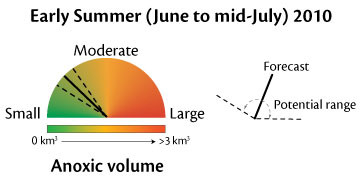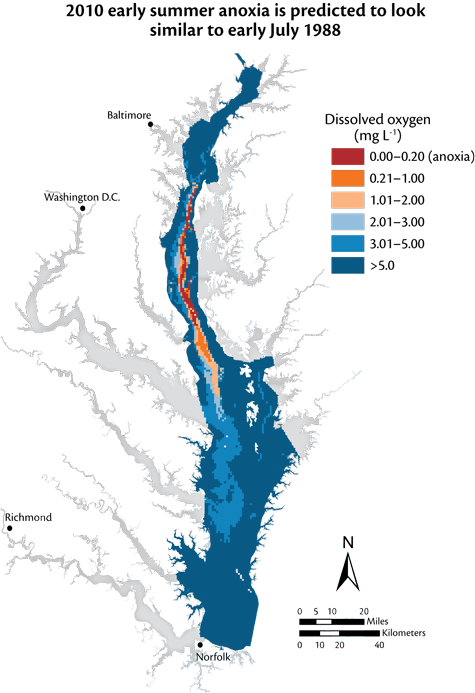The Next Frontier: Ecological Forecasting
Bill Dennison ·The weather is often the main topic of discussion amongst friends, around the office water cooler, and even between strangers. The professional meteorologist is one of the most maligned positions in our society. Yet everyone cares about the weather forecast; so much so there is even a 24-hour cable station dedicated to providing every detail about temperature, humidity and the relative chance of precipitation at 3,000 locations nationwide.
In this region, the condition of the Chesapeake Bay ecosystem is just as important a facet of our daily life as are weather conditions. Scientists are now undertaking the challenge of developing the capacity to provide "ecological forecasts."
Ecological forecasting provides a glimpse into the future environment by predicting the effects of biological, chemical, physical, and human-induced changes on ecosystems – similar to the way a meteorologist predicts the weather for the seven-day outlook. Like weather forecasts, ecological forecasts do not guarantee what is to come – they offer scientifically sound estimations of what is likely to occur.
As we've recently read in the pages of newspapers, we still have a long way to go toward a clean Bay. But in the meantime, we can take advantage of this new scientific technique to give us a better idea of the likely conditions the Bay's rockfish, crabs and oysters will face in upcoming months.
The Chesapeake is an especially appropriate place to begin this journey of scientific discovery. It is the best studied estuary in the world and the region is home to one of the highest concentrations of scientists in the nation. However, in spite of this solid foundation, the challenge of forecasting complex ecological processes is formidable.
Every summer, the Bay's bottom waters become depleted of dissolved oxygen. Oxygen, essential for the fish and shellfish that inhabit the Bay, is consumed by bacteria that breakdown decomposing matter that has fallen to the Bay's floor. In recent decades, these bottom waters have become critically low, forming a 'dead zone'.


The extent of this 'dead zone' can be related to the amount of nutrient runoff that fuels the growth of tiny plants in the Bay. Scientists have recently been able to link the amount of nutrient pollution flowing into the upper Chesapeake Bay in the spring freshet to the extent of the summer 'dead zone'.

While scientists hope future forecasts will be able to help resource managers target restoration efforts to accelerate the cleanup of the Bay, activists see forecasting as a way to get the public more attuned to the health of the Bay.
Ecological forecasting gives watershed residents a glimpse into the Bay's future and can reinforce the linkage between our lives and those of the rockfish, crabs and oysters that call the Bay home. Hopefully, this will spur more action in the restoration of our Bay.
We have learned a great deal from these past two summers of Chesapeake Bay ecological forecasts. Foremost is the lesson that we don't know the Bay as well as we may have thought. But this type of rapid-response scientific analysis is the wave of the future. Instead of publishing scientific papers years after data collection, forecasts are pushing the envelope of scientific inquiry.
In a culture that expects to see images of weather events taking place thousands of miles away within minutes on television, scientists need to find ways to provide resource managers with rapid feedback on the success of their restoration efforts. To this extent, forecasting conditions in real time is challenging our capabilities as the complexities of nature make this a difficult task. But the value of having advance notice of ecological conditions to help guide restoration activities and aid in better management of the magnificent Chesapeake Bay is worth the effort.
About the author
Bill Dennison

Dr. Bill Dennison is a Professor of Marine Science and Vice President for Science Application at the University of Maryland Center for Environmental Science.

